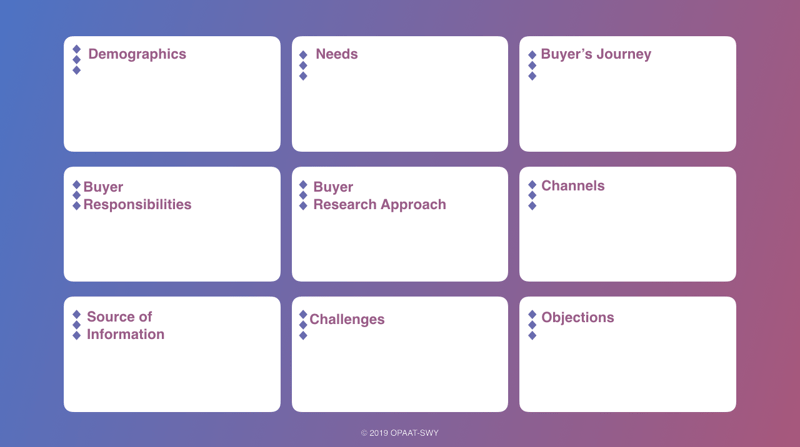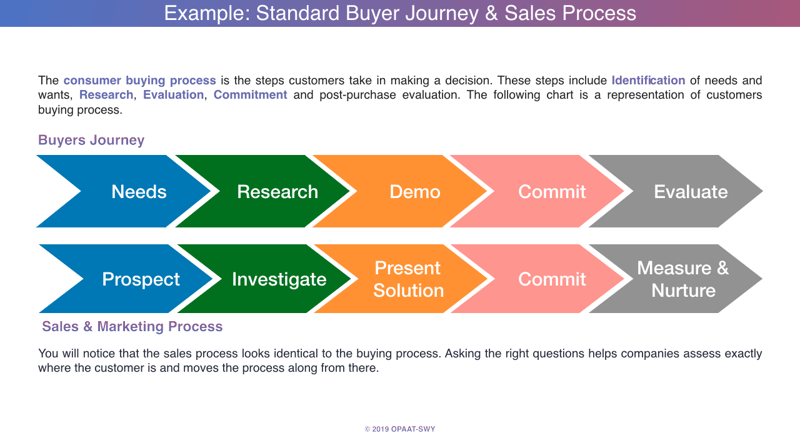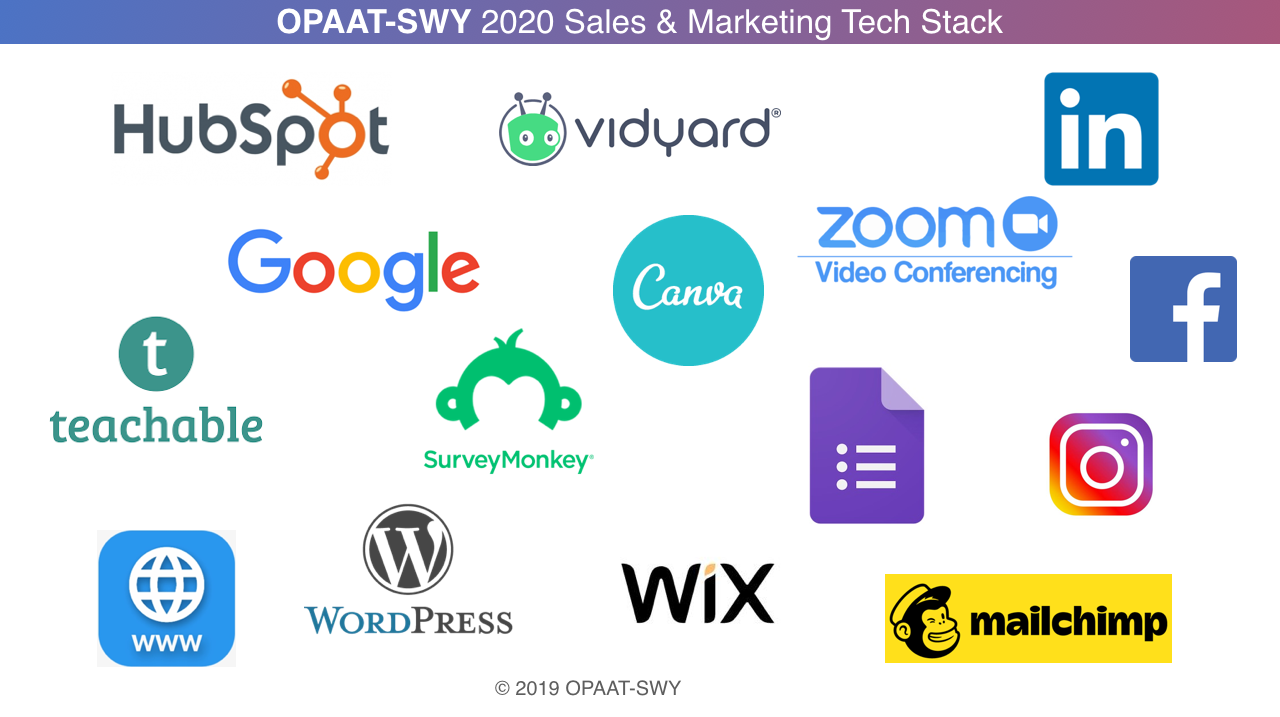As we approach the year's end, most companies are either hustling to get to their year-end numbers or thinking of what can be done differently and more strategically for 2020. One common KPI is growing business through new accounts or optimising each customer's annual spend with your organisation.
While there are many strategies companies can adopt to achieve this, most of them are not always strategic/targeted in getting the sales and marketing teams focused on growth strategies. In many instances the approaches are scattered, they require a lot of energy, they can't be measured and bring no real-value back to the organisation or the customer.
So what the answer?
For us here at OPAAT-SWY, we’ve found that grouping/segmenting our clients into verticals to be one of the best approaches as it gives us a greater understanding of our clients as collective and individual entities. That way we learn how we can deliver to their specific needs.
So what’s required to really get this going? Let's break the two down so that we can get a better appreciation of the two and how it can benefit your organisation.
1. Bring The Teams Together
2. Review Your Value Proposition
3. Identify The Persona(s)
4. Map The Buyers Journey To Your Sales Strategy
5. Develop an Engagement Strategy for Each Stage
6. Create a Tech Stack for Each Stage
7. Measure Progress

1. Bring the Teams Together
This is possibly one of the most important steps in developing an approach to specific verticals. The two main stakeholders are the marketing and sales teams. However, other teams such as service, IT, finance, operations, etc. play an integral role in attracting, engaging and nurturing the right accounts.
Sharing the overall goal, objectives and approach to each department starts the process for a philosophical change within the organisation on how they work with their customers. This approach is not a standard approach in Trinidad & Tobago but one that we believe is required as buyers and their behaviours have changed and companies are a bit behind the curve in connecting with them across all levels of the organisation.
2. Redefine Your Value Proposition
This is where both teams really need to be specific on what they are saying to their customers. It’s recommended that teams sit and really relook and state exactly what they're offering to customers beyond the product or service.
Yes, it’s a piece of software but exactly how is this going to impact the organisation from a productivity, profitability, image, convenience or experience standpoint. Those are just 5 of the many different value offerings that a company offers and it’s crucial that companies relook and restate this for 2020.
A good approach is by doing surveys but we have found one-on-one interviews with your client personas most effective. This creates an intimate opportunity to connect and find out how much value you are really offering and where you can improve.
3. Identify The Persona(s)
So you’ve identified the accounts…great!!!
Now, who are the people you need to speak with? This question is always a stumper when chatting with sales professionals because they mainly have one persona in the account that they go to. This person sometimes has either some or no level of influence in the account. Even if they have some level of influence, your product, service or solution does not impact just that one person.

Every account has many different personas who we can also call influencers and unless we understand how what we sell impacts them each of them then we will always be operating with missing information.
Even if you are unable to meet with each persona, encourage your main contact to find out as much information for you as they possibly can.
Here are some things to find out;
-
Their Company/Department goals
-
What’s important to them and their function?
-
Why is that important to them as a company/department?
-
How are they going to achieve it?
-
How will they know it's achieved?
-
Where will they be going to get information?
-
How will success be measured?
-
Challenges in achieving “X”…if any
Also pay attention to things such as position, age, gender, size of the team, etc.
With this information, marketing can start developing targeted content to support, nurture and attract those persona(s). This also grows the mind share of new and existing customers.
4. Map the Buyer’s Process To Your Sales Process
One important question sales or marketing professionals must ask their customers (new/existing) is “what’s your process?”
This is where the philosophy of marketing and selling to verticals really starts changing. Currently, sellers make customers buy the way they sell and not sell the way their customers buy.

While interviewing your persona(s) make sure and ask them;
-
What’s the process?
-
What happens at each stage?
-
What does it take to move forward?
-
How rigid is the decision making criteria
-
Who gets involved at different price ranges?
The above are just examples of questions to help you better understand the buyer’s process but they give the teams a better appreciation as to how they need to market, sell or adjust operations to reduce friction with their customers.
5. Develop an Attract & Engagement sales Strategy
You’ll notice that the first fours stages focus more on mindset than the customer. It indicated that companies should take a fact-finding approach and once that information is gathered then and only then can marketing and sales really look at putting the right strategies together to attract and engage customers.
These can be a combination of outbound and inbound strategies where marketing becomes the main driver or magnet in promoting the right things to the right people to raise awareness & interest, once pre-qualified they are then passed onto sales for an engagement at a high-level.
Some Attraction & Engagement Strategies are:
Marketing
-
Blogs
-
Adverts
-
Social Media
-
Marketing Demos
-
Customer Testimonials
Sales
-
Sales Prospecting
-
Call & Email Scripts
-
Qualifying Questions
-
Sales Demos
Keep in mind that each one would be specific for each vertical, which would show the company as an industry expert/thought leader in their space.
6. Create a Tech Stack
Even without the implementation of a vertical market approach, companies cannot ignore the value of technology in today’s world even for the most basic day-to-day tasks.
Here are some ideas as to what should be in your 2020 sales and marketing tech stack for each stage of the sales and buying process.
2020 B2B Tech Stack

As we move into the 2nd decade of the 21st century not integrating technology into your sales approach, would be a major disservice to both you and your customer.
7. Measure Your Progress
Last but not least and just as important as all the other steps is to measure your success.
A key point to keep in mind is that this strategy is a long term strategy. Meaning, it’s a process that takes time but once done right it then becomes part of your company’s culture and accelerates growth from there.
These are some key success indicators;
Buyer (Customer):
-
Buyers achieve growth through seller support
-
Customer Satisfaction
-
Buyer experiences more personalised engagement with their sellers
-
Buyer-Seller Partnership
-
Trust-based relationship
Seller:
-
Longer Customer Life Time Value (CLTV)
-
You become an industry leader
-
Increased deal size
-
Improved customer relationship
-
Sales Reps become Sales Consultants
-
Improved Sales Process
-
Sales-Marketing Effort Synchronisation
-
Key differentiator
-
Increased Customer Success/NPS rating
In closing, the term buyer/customer-centric shows up in many vision/mission statements. However, while some company do have a good focus on their customer, there is always room for improvement. I strongly suggest that companies look at this approach and see where they can improve.
In many instances, the improvement will be in the way they market and sell to their customers and if they begin adopting some if not all of the suggestions made we are certain that 2020 and beyond would be an extremely successful year/decade for both you and your customer.

RELATED ARTICLES
Rebuilding Sales Pipeline After Losing a Major Client: Key Strategies
Every sales leader, entrepreneur, and business developer discusses pipeline strategy, but few discuss its gritty, real-life ...
Start Reading
The State of Sales Training in the Caribbean: A Call for Change
Disclaimer: This post is not intended to critique any specific individual, organisation, or training program. Instead, it is an ...
Start Reading
8 HubSpot Academy Courses to UPSKILL your Sales & Marketing Game
While the events of 2020 made time for people to learn it also highlighted gaps in how many company’s sales and marketing teams ...
Start Reading


.jpg?width=575&name=OPAAT-SWY%20Youtube%20Artwork%20(7).jpg)
COMMENTS